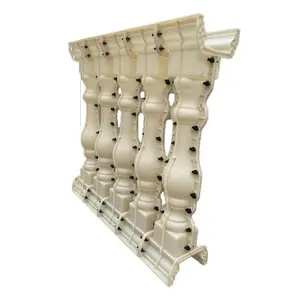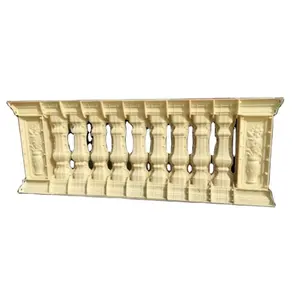(1424 products available)





























































































































































































Concrete balcony spindle molds are diverse, depending on what kind of baluster they create. They help users produce spindles with uniformity, thus speeding up balcony construction processes.
This mold creates cylindrical spindles. Circular spindles are among the most commonly used. This is because they fit most design types. Concrete railing made of circular spindles usually has a neater look with a smooth finish.
This mold creates square spindles. Balusters with square spindles are ideal for contemporary structures. The square shape gives concrete railings a more structured and tighter look.
A colonial baluster mold creates spindles with a traditional design. The spindles have curved profiles and often end with a decorative base. These spindles work well in concrete railings for customers who want a classic or vintage look.
This mold produces spindles with straight and flat cuts. These molds are commonly used in modern rail designs. The flat cuts provide a sleek and stylish look.
The model above is a stock solution. But one of the most effective and, therefore, commonly used solutions is custom-made molds. Users can pay to have unique designs carved into their molds. Such options would likely be suitable for unique or branded architecture.
The main material of the concrete railing baluster molds is the concrete itself. Besides, there are a few more details about that. It all depends on the kind of finish, longevity, and even looks users want to achieve. Concrete can be resistant to environmental factors such as moisture and UV rays. However, there are other materials users can choose from.
Plastic is commonly used in every industry due to its relatively low cost. Plastic is lightweight and easy to handle. It is also very flexible, which reduces the risk of breaking the mold. However, heated concrete can damage the details, so plastic molds are often used for smaller projects.
Steel is noted mainly for its strength and durability. Steel molds are made with enough thickeness to withstand cement's high temperatures and pressures when it sets. Steel molds are best for users who need luxuriously strong and long-lasting molds. However, users should be aware of steel's higher cost and weight.
While steel provides strength, aluminum is lighter. This makes it more manageable during use. Aluminum also resists corrosion. This gives it an edge when used in outdoor and architectural settings. Concrete can damage plastic and wood over time. That is why aluminum is more costly but good for long-term use.
FRP molds combine fiberglass's strength with plastic's lightweightness. This gives users a sturdy and modular mold. The material is flexible enough to create intricate designs while tough enough to handle multiple castings. It works well to protect the mold from the heat generated by curing concrete.
Rubber linner is often used for classic design molds. The flexibility of rubber allows for detailed designs, which makes it easier to reproduce small, intricate details on the baluster. Rubber molds are also easier to demold. This is a huge plus for production lines since they expedite the process of removing cured concrete objects.
Refer to the guideline below to provide the right concrete baluster brass molds to clients
Various molds will yield various designs. If the client wants a simple or modern design, recommend a wide-scope spindle mold with straight and flat cuts. The mold for clients who want a classic look is the colonial baluster mold. A circular baluster mold will suit clients who prefer standard designs.
Concrete decisions have to be based on budgetary considerations and project needs. Plastic molds have been proven easy to handle, but they are less durable than steel or aluminum molds. Users should choose fiberglass molds for high-precision jobs.
The more detailed the mold, the more detailed the resulting baluster will be. On the other hand, highly detailed molds require more maintenance work. Also, highly detailed molds are likely more costly.
How large the project is should guide which mold to buy. For small projects, plastic or rubber molds will suffice. They are lightweight and affordable. Large projects would need more robust molds made of steel or aluminum.
For clients intending to do more projects in the future, advise them to choose long-lasting and robust molds like steel or aluminum. Concrete will damage plastic molds over time. That is why fibreglass-reinforced plastic molds are suitable for long-term projects. While rubber molds offer easy maintenance, they wear out quickly.
Concrete railing baluster molds have a widely desired attribute: versatility. They can be used to create railings on numerous structures, including residential and commercial structures.
Molds can be used to manufacture concrete balusters for style and utility in residential structures. Think of the house's porch, patio, or even staircase. The resultant balusters boost the area's curb appeal and provide safety. It works well for residential areas with traditional designs. Custom molds are also useful for people who want unique designs.
In commercial environments like hotels or retail spaces, baluster molds help achieve a desired aesthetic or brand style. Moreover, mass production of balusters can reduce costs. It will also ensure consistency in quality. Simply put, the molds are suitable for achieving a particular stylish look and providing bulk production.
Specific adjustable spindle molds are used in historical restoration work. These molds recreate old designs to preserve a building's unique architectural features. Historical buildings benefit from such spindles. They aid builders to digitally preserve a building's original design.
Molds aren't just limited to structures. Landscape architects use spindles in outdoor spaces like parks or community centers. It will provide safety on pathways, decks, or viewing platforms while maintaining a harmony with the surrounding design. Colonial baluster molds are ideal for landscape architecture.
Concrete spindles can be used externally and internally in ships. In shipbuilding, smooth concrete mold spindles are typically used for internal ship railings. The durability and heavy compactness of the materials make the balusters ideal for use in variable pressure conditions. In modern shipbuilding, a spindle mold can be used to create trendy rail designs.
The right and timely maintenance of the spindle molds have a compelling effect on their lifespan, functionality, and value. Cleaning the molds after use prevents concrete buildup. It helps maintain the mold's integrity and usability. The kind of maintenance required depends on the kind of material the mold is made from.
Users should clean plastic molds using warm water and a gentle detergent. They should wash before the cleaning water transforms into room temperature to prevent cracking. Users should avoid harsh chemicals that can damage the plastic. They should store the mold in a cool, shaded area to avoid sun damage.
Clean, minimal upkeep, and steel are strong. To maintain steel molds, users should frequently apply a releasing agent before each use. It helps remove concrete from the mold. After casting, clean the mold using a steel brush or a pressure washer. This removes any concrete residue. Applying a thin layer of oil helps prevent rust. Store the mold in a dry place to avoid condensation.
Aluminum molds are low-maintenance. Recommend users to apply a release agent on the mold prior to each use. Clean the mold using a soft brush or sponge after each use. Users should avoid using steel brushes as they can scratch the aluminum surface. Store the mold in a dry area away from direct sunlight.
FRP molds are lightweight but offer robust service. Clean the mold using a mild detergent and water. Fiberglass requires the use of a soft brush that won't harm the surface. After cleaning, the user should inspect the mold for damage. Store the mold in a cool, shaded area out of direct sunlight.
Rubber molds require more tender care. Wash the mold with warm, soapy water after each use. Avoid using sharp objects or abrasive cleaners, which will damage the mold. Apply a mold conditioner or mold release after cleaning. Store the mold in a cool, shaded area away from direct sunlight.
A1.Concrete itself lasts long. So, users must first ensure the concrete used is of quality grade. Next, the concrete should be poured and compacted using the right pressure. That is how sturdy concrete railings come about.
A2. Yes, there are many retailers with machines that can create personalized spindle molds. They can be cad cut to create specific designs and designs that have not been imagined yet.
A3. The concrete forms' longevity depends on the kind of material they are made of, their usage frequency, and the environmental conditions they are exposed to. Usually, plastic and rubber molds may need to be replaced after a few years. Steel and aluminum molds can last for decades with proper maintenance.
A4.Several hybrids use both spindles and posts. Ideally speaking, a good concrete baluster mold makes railings that provide security and improve how a place looks and feels. It even does that while making the costs quite affordable.
A5. Yes. That is the good news. They are produced individually. Clients who want specific details, like particular markings or shapes, can pay to get personalized molds. It also gives their railings a distinct appearance.